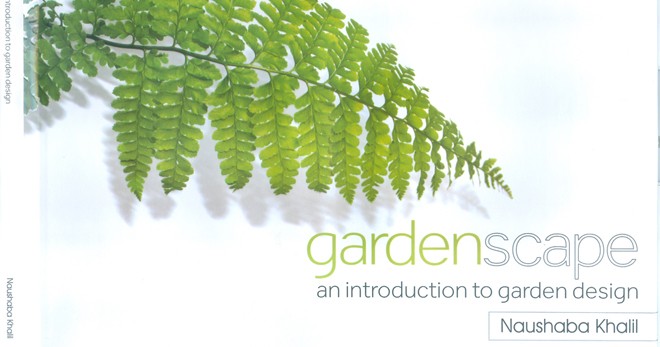

For a gardening illiterate like this reviewer whose only saving grace perhaps is that he thinks he knows a beautiful garden when he sees one, this book is a compact, concise, elegant first step to an education in gardening. Written in short, informative sections that cover apparently all aspects relevant to an "Introduction", the book contains vivid photographic images (mostly captured by the author’s husband, Khalil Sattar, and daughter Daniya) to illuminate the path to understanding the subject. The book’s own lay-out is simple yet spatial: white spaces between words and pictures create an aesthetic design. The cover with a beautiful fern aptly sets the tone.
At the same time, this is a book by a specialist that other experts may also appreciate for its contribution to raising knowledge and awareness about this subject amongst non-specialists. Penned by an international and national prize-winning gardenist, the content spans a wide spectrum. Beginning with the principles and elements of garden design, the second section covers plants, fragrances, trees, shrubs, climbers vines and trailers, hedges, lawns and borders.
Moving to "Masterstrokes", the next section reflects on what can be done with a hard landscape in increasingly arid conditions, with how water, plentiful or scarce, can become a focal point, with how the use of diverse materials chosen with care can make walkways express different moods, with how furnishing the space outside the house and inside the boundary wall can fuse flexibility and functionality.
Brief paragraphs take the reader on a whirl-wind tour to glimpse the range and richness of styles from East Asia to West Europe. In Japan, the use of rocks and stones conveys multiple meanings. Every stone has a name and an attribute ; the arrangement of each in relation to the other expresses a theme. In Moorish Spain, arches and water, exotic plants and patios summarise a distinct grace. Persia inspired continuity between interiors and exteriors, stressing the use of light to illustrate pieces of paradise on earth. The Mughals extended scale while retaining symmetry. They used canals, roses and fragrances to imbue spaces with romance.
With geographic and cultural variety there are also other categories. In a cottage plot, a profusion of plants, fruits, vegetables and flowers. In the wild and woodland kind, depending on the location of a private structure, there is scope to enable oneown green space to reflect and blend with the surrounding area. A vegetable garden’s potential has expanded in recent times to enable visually attractive arrangements to be combined with convenient production of healthy organic food. In pots or on the soil itself, a choice of herbs can provide traditional cures for ailments as also bring taste and aroma to the dining table. To acknowledge the rapid increase in multi-storied accommodation, there are helpful guidelines for maintaining green spaces in apartments and in vertical forms.
Small yet sharp, clear pictures bring the colours and textures of flowering plants to life in the Plantography section. One learns that the Orchid family is not content with as many as 25,000 native species found around the world. By inter-breeding, another 30,000 hybrids have been added to bewilder a beginner. From bulbous tulips and roses to tenacious cacti and succulents, the book becomes a neat album of dozens of species, noted in both their popular names and their Latin titles. Tree leaves look like treats, be they the "akas neem" or the amaltaas, the gul mohar or the flame of forest.
As private retreat or as public park, as splendid spread or as modest front-yard, as metaphor or as myth, gardens nourish a spiritual bond. In times when the built urban environment and gluttonous consumption of natural resources degrade the un-built environment, each garden, large or small, becomes a precious Protected Area, a strategic stake-out, a territory of immense ecological value. Without explicitly dwelling on this theme, the book presents a powerful case for conservation and sustainable preservation of nature’s treasures.
Eminent persons with a special love for gardens record their appreciation for the book’s quality and the author’s work in their respective comments that precede the text. These include rich tributes from a pioneer horticulturist such as A.K.Khan, the founder and Life President of the Horticultural Society of Pakistan, Salim Abbas Jilani, the respected former CSP officer and Caretaker Federal Minister and current Chairman of the Society, Lt. General (r) Jehanzeb Arbab, former Chairman, Ashraf Sanjer, a leading architect and urban designer, Dr Imtizaj Hussain, Secretary, Ministry of Agriculture, Professor Dr Javed Zaki, University of Karachi.
Naushaba Khalil begins her Introduction by an evocative recall of the past and by the statement of her aim. She writes:"As a child I was fascinated by the enchanted universe that was my mother’s garden….I believed that it was by some magic that the grafted rose bush was laden with candy pink roses on one side and crimson red on the other !….I wish to encourage (others ) to plant more enchanted gardens which will not only give delight today but will also inspire the green thumbs of tomorrow."
For garden-makers or for garden-gazers, this ever-green book becomes a pleasure to possess.